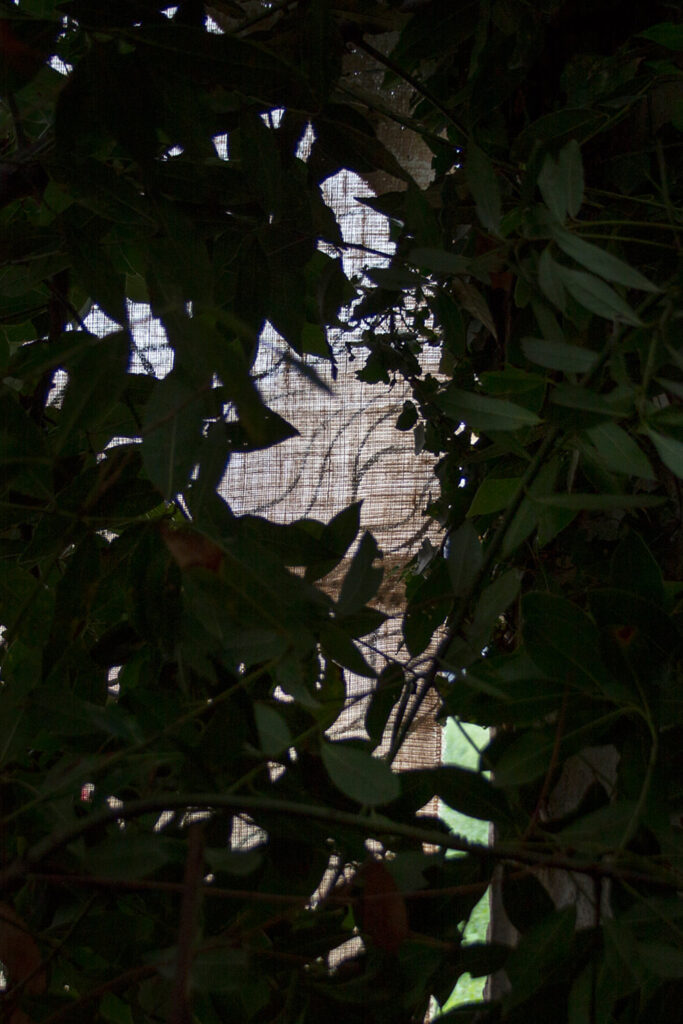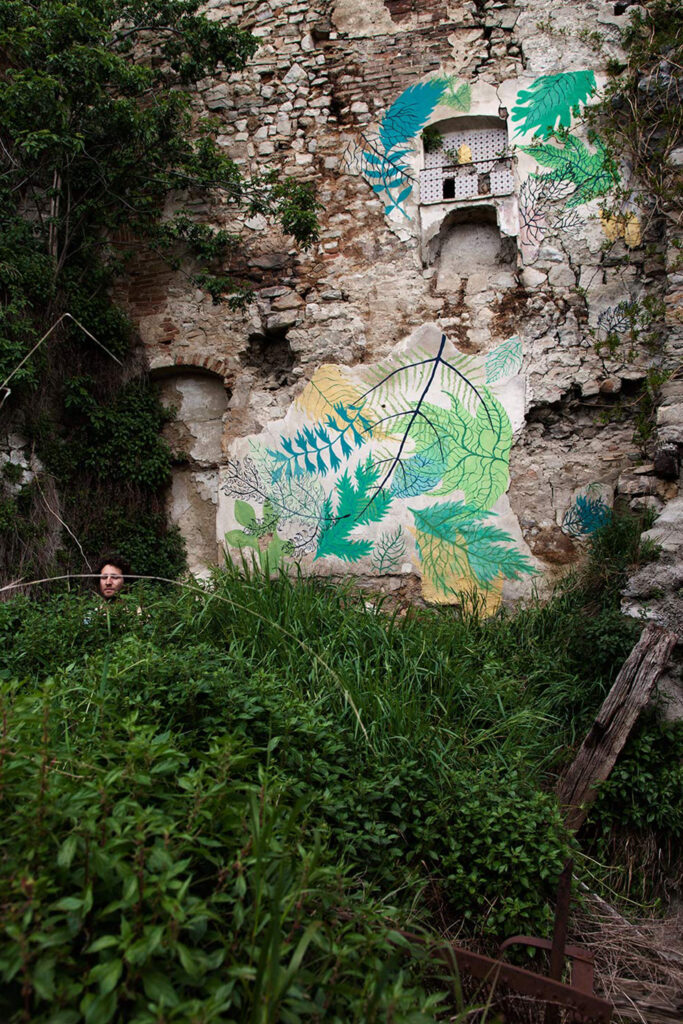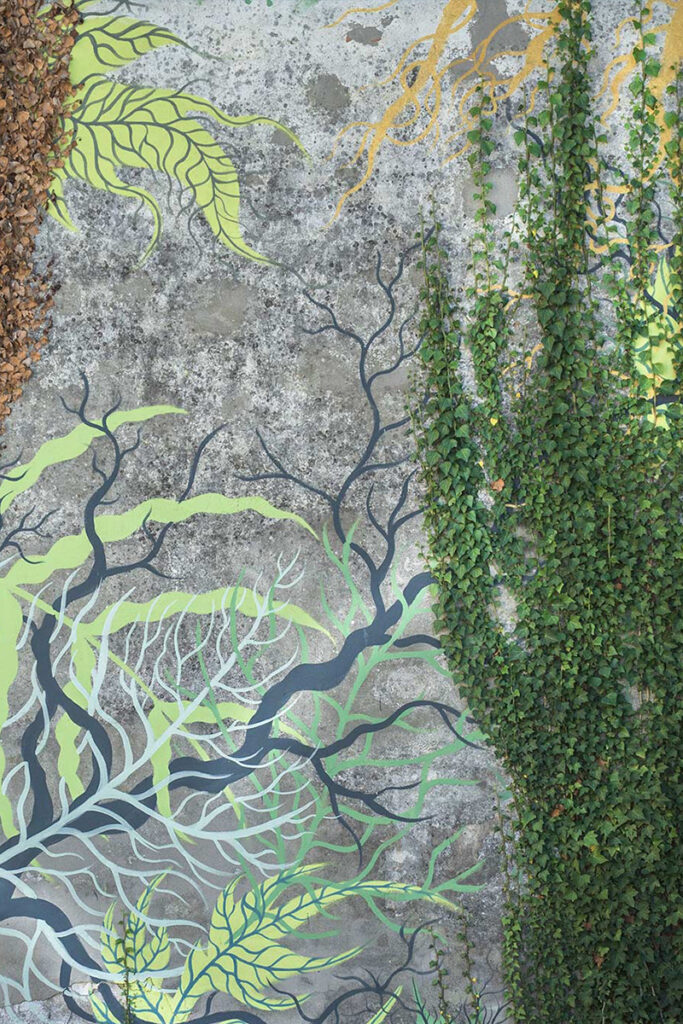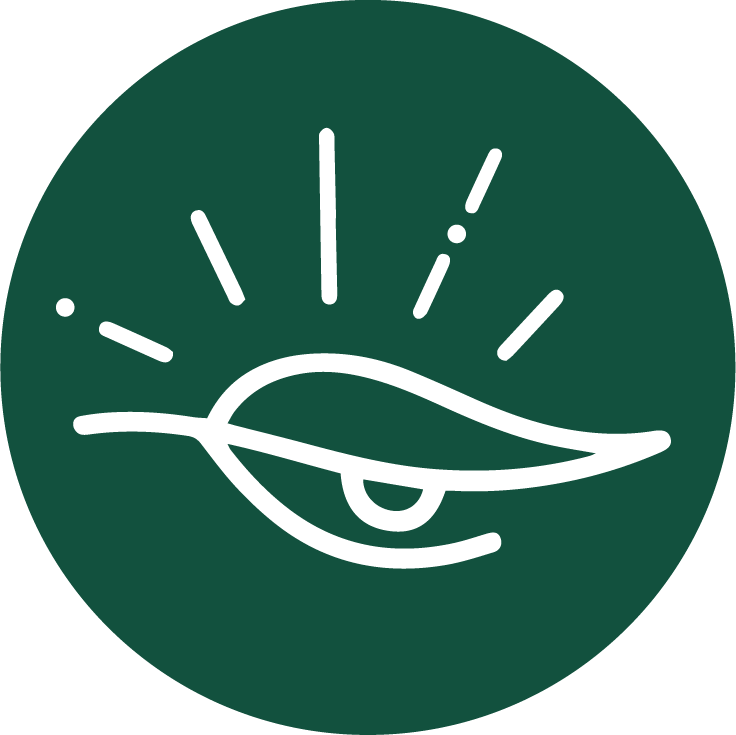I project and install nests and shelters for animals who live in the city, especially birds, Chiroptera and insects, to return to them a little bit of the space that the human being has reclaimed as their own. I’m fostering the growth of climbing plants on walls of the city, or I suggest planting endemic trees that can create food for the urban fauna.
Gola HundunCreating for the Biosphere | Gola Hundun

Gola Hundun’s work shows the relationship between human beings and the biosphere.
The universe he creates has always had an allegoric interpretation and is enhanced by many influences such as post-human culture, sacred art, zoology, psychedelic art and the many cultures he has found and still finds throughout his travels around the world.
Besides his work as a painter, Gola Hundun also creates public installations incorporating fiber, living plants, music and live performances.


What does oneness mean to you?
In my opinion, it means that we are one with the whole and every action has consequences, as much as you are an active part of the action or when you are the receiver. We have to understand that the way and meaning of action will bring the interconnection, therefore it’s important what we do and how we do it every day.
Oneness means for me to realize that every living and non-living being that are existing in a certain space connects and to understand and feel that this inextricable relation must be the basis of existence. I think the sentient foundation of life is not only the struggle for survival or self-affirmation but these trends are united with the consciousness of coexistence.
I think that every living organism feels these thing in different ways, consciously or unconsciously, however from a human being as an animal that has been brought to broaden his mind as a method of evolutionary adaptation, I would expect a greater awareness of the fragile balance of coexistence.
In ancient societies or in the few contemporary communities living in close contact with the natural territory this consciousness of ‘oneness’ still survives as guidelines for actions and decisions, because the Earth coincides with the home and sustenance of these people.
However, it’s difficult to find it in the countries and in the cities of this generation, where capitalism and maximization of profit have become the global reference model.

Your work visualizes relationship between human beings and the biosphere. How did you come to this realisation and how do you incorporate this relationship into your daily life?
Through my work, I try to describe the beauty of life’s complexity and to visualize the strength and completeness felt when you are inside of something that i normally call “the real world”, it is a non-artificial space, a wood, the banks of a river or the summit of a mountain… I try to evoke this feeling for those people who spend most of their time in a city by choice or necessity. I try to make people feel a little bit of the constant interconnection with the life itself, the perfect balance between life and death, like a game that you feel in every moment when you are in the nature and that makes you feel part of this game, connected in the present and with what you are doing.
The city is an unnatural bubble, a habitat invented by human beings for the consumption of the human only, there is no space for the necessity of other living beings, except for those who attend to a human being or those who learned to play by his rules, however, most of them are cast out or seen as a problem. Living in a city does not give birth to empathy towards other life forms for most of us because we don’t know about them and therefore we fear, as is the case of the wild animals, we consider them like a commodity created to perform activities or to obtain raw materials, like the tamed animals. For centuries every man commits atrocities towards other living beings, the earth, and the ecosystem to meet the demand of raw materials for consumption (today we depend on the most frivolous and unnecessary items for existence), because of this lack of empathy for other lives, we are struggling to find a connection. The enemy of the sense of coexistence is, in my opinion, maximum exploitation.
From an early age personally I felt curious about different types of life forms, and when I was 15 I discovered the possibility of vegetarianism. I studied ethology of other beings and our impact on their life. I decided to live like a vegetarian and sometimes vegan. Furthermore, we know today that the meat industry and the fashion industry are amongst the first causes of pollution and lack of potable water.


There is a big contrast between the grey of the urban architecture and the colorful shades you use, what’s the idea behind it? Is it a way in which you proclaim nature conquering her space in the urban dimension?
Details and colors are the base of my language that allows me to talk about nature inside the city spaces. The walls allow me to talk, not only to a sensitive examiner about these themes but to the town, or at least to those who live in a particular city district, but also to people who are out of the world of art, this is very exciting for me.
I’m trying to load the mural or installation project with a more direct action of supporting the proclamation of urban spaces by the nature.
I project and install nests and shelters for animals who live in the city, especially birds, Chiroptera and insects, to return to them a little bit of the space that the human being has reclaimed as their own. I’m fostering the growth of climbing plants on walls of the city, or I suggest planting endemic trees that can create food for the urban fauna. Moreover, the cities are getting bigger and bigger and more alien to other life forms, the continuous urban planning reviews aim to generate increasingly smooth surfaces with the tendency to flatten the gradients both in walking and in the vertical ground depriving in my opinion visual stimuli for the citizens and the possibility for the fauna to find niches and shelters under a linear walking.
The feeling that I have developed in recent times is that the virtual world has become the ultimate form of disjunction between human and natural habitat, that, over the last 30 years, we have lost a lot of the original free fruition of the culture and users horizontalization, it has become a reference system of what is “real” in the sensitive reality, in addition, it is also a powerful tool to control the human society. I think that human interactions are moving more and more in the virtual world and that it is the beginning of a particular historical phase. Also, the Metaverse creation underlines this feeling of another sensory world, lately, I often compare the relationship that people are accepting to have with the virtual world, to the one that the people in the medieval era had with the “heavenly kingdom”, in the sense that what is important and “real” is in this two incorporeal kingdom, so what happens in the sensitive world it’s not important, and who administers the humanity can work how he prefers in the real world because today more than yesterday it is seen as a mere stock of raw materials.

Humans are essentially animals, why do you consider your work closer to the animal sphere rather than humans? Do you think humans are animals that have forgotten to be wild?
The human being is biologically an animal full-fledged yet, but for many centuries, especially in western societies, he declared himself something different, something superior to the other forms of life, a conception so ingrained that we can find it at the base of every human/nature argument with every person of every class, inside of dominant societies. These beliefs arise from human/nature dichotomy and they are rooted in the hierarchical and pyramidal division of life in Plato’s thought, that after the great monotheists (especially Christianity and the others that came later) have made them their own and making them more strict and simplified. In my opinion, the monotheists, with their worldwide spread, had been the players of this culture that see the humans separated and uppermost the animals, which are born “to be human’s food” how these religions teach us, as well as the Earth borns to be exploited for human purposes. The diffusion of this thought has made the rise of capitalism possible, that, how we know, it aims to maximize production for ever-growing profits, while the space and the resources are limited; we can see the consequences in our world.
Prehistoric populations venerated the animals for their supernatural abilities or they examined their prowess allegorically in the ancient philosophies, starting from the end of the Roman Empire in the West to the postmodernity era they are considered only as our utilitarian appendices.
Another aspect that has contributed to the anthropocentric conception is the trust of humankind towards their logical ability, which has been popularly accepted over time as means and measuring stick of their supremacy over other living beings, when in fact the first ethology studies and other living beings “culture” belongs to XX century but only in the last 10/20 years are making discoveries which question this primacy in the Vegeta neurology, animal empathy, interspecies communication… The human being tends to recognize and proclaim as “smart” only one type of intelligence and social organization that is similar to theirs: for example the social insects. The human being has always taken this confidence and specialization to the logical part of the brain, when in fact the mind is a seat not only of single logic and of rational thought, but of creative and irrational thought, of intuition (that it could be critical for the interspecies communication and explore the possibility of the telepathy), of empathy, analysis, abstract thought, etc…
I think that the logical thought is so identitary for our specie that today it has strengthened until the creation of the computer, and the artificial intelligence, that I have started to see as a new species. I think also that soon the human will start to feel like imperfect beings also on the logical side compared to artificial intelligence because machines today already have much more computing power than humans do.
We continue to identify with logical aspects but at the same time, we continue to be animals, moved by irrationality, ritualism, and other irrational aspects. I think that everyone begins to perceive the rhythm of life inside of human society as alien concerning the biological rhythm, the hyper-connectivity that mobile phones have generated already shows the incompatibility with our biological rhythm which is made by activity/rest, waking/sleep.
So we are “animals” yet but we are driven by ourselves to become machines of profit optimization, we start to have some part of our body that is not animal through medicine (parts that require continuous maintenance) and the telephone has become an extension of the body without which we can’t be part of the human society. History tells us that our species must reach a breaking point to understand and take a decision, many of us are wondering what it should be the right attitude for our life on the earth and how to lead it, but who rules society if it is still led by the ancient hierarchical and pyramidal model.


Your work is influenced by post-human culture but also sacred art, how do you balance these two completely diverse phenomena in your creation?
The Post Human culture is dear to me as a cultural reference, like a way out from the Anthropocentric conception, which is not external to sacred art I believe, cause a lot of sacred art especially in ancient times but also in the modern and sometimes contemporary, use animals and biosphere phenomenon to depict supernatural powers, shape divinity, and miracles.
Lately, my research brought me to focus on the exploration of abandoned buildings that have been taken over by nature creating hybrid spaces that I see as temples of coexistence.
Few magical spaces with mixed aesthetic of what remains of straight lines of the buildings and of biological forms of plants and lichen. This part of my work is called “Progetto Habitat”, it is the result of exploration inside and outside of the urban world, through which I make ephemeral installations especially guided by the gold color to symbolize the sacredness of the place that becomes a temple to nurture’s recapture. These places make me imagine the post-anthropocentric era. These pilgrimages and meetings feed my studio work.

As an individual and as an artist do you consider yourself as a medium to spread awareness regarding current climatic issues?
I think of my work before it is a handmade article, there has to be a message before aesthetic realization.
The starting and the arrival points are the messages that my work allows me to do, by using a universal language: the picture. Which is apparently an indirect language but it knows how to talk to the deepest layers of our minds or spirit.
Sometimes it tries to stimulate the viewer to feel part of the big circle, other times it tries to put an exclamation mark on the injustice that we perform in the name of profit and “wellness” as comfort which I think is one of the greatest evils of our time.


Gola Hundun @GolaHundun




